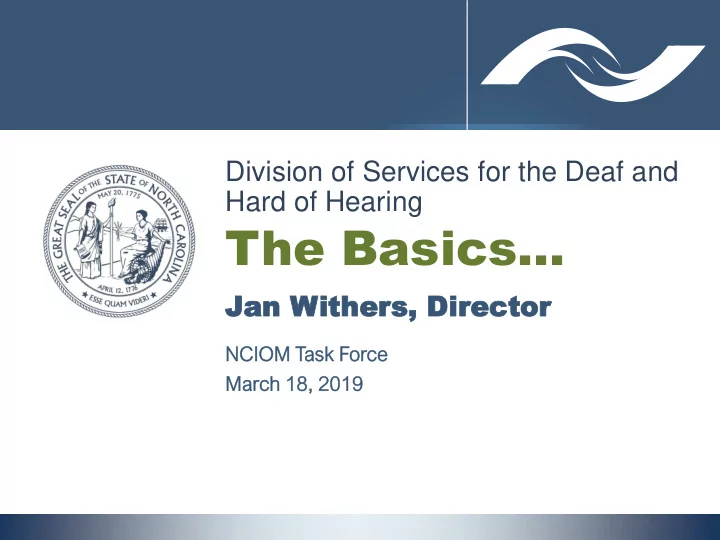

Division of Services for the Deaf and Hard of Hearing The Basics… Jan an Withe ithers, s, Dir Direc ecto tor NCIOM IOM Task ask Force ce March ch 18, 2019 19 NCDHHS, Division of Services for the Deaf and Hard of Hearing 1
Ba Basi sic T c Ter erms ms You ou Ne Need ed K Know ow • Deaf • Hard of Hearing • Deaf-Blind • Deaf or Hard of Hearing with Low Vision • Late Deafened • Deaf Plus • Hearing-Impaired • Hearing Loss • Intersectionality NCDHHS, Division of Services for the Deaf and Hard of Hearing 2
“People - First Language” • Widely used by people with disabilities. • Exception: Culturally Deaf people – those who use American Sign Language (ASL) and are members of the Deaf community • Reason: Deaf identity as a source of pride and view of Deafness as a culture • This sentiment is not as strong among hard of hearing people, though it is acceptable to many to say “Hard of Hearing people.” More commonly- used is “people with hearing loss.” NCDHHS, Division of Services for the Deaf and Hard of Hearing 3
Ame meri rican can Sig ign La Langu guag age • A true language that meets all linguistic requirements for a language • Not “universal” – there are hundreds of sign languages around the world as well as regional dialects • Rich and sophisticated – capable of conveying complex, nuanced, and/or abstract concepts • Prelingually Deaf children face challenges in acquiring language, usually because the early intervention and education systems are inadequate in ensuring language acquisition and literacy NCDHHS, Division of Services for the Deaf and Hard of Hearing 4
Com ommu munic nication ation Rule les Given the wide variety of communication methods used by meeting participants, communication rules serve to ensure all meeting participants have an equal opportunity to participate in a meeting. • Raise your hand if you want to speak • Wait for facilitator to recognize you before speaking • State your name before speaking so that the Deaf, Hard of Hearing, or Deaf-Blind participants know who is talking NCDHHS, Division of Services for the Deaf and Hard of Hearing 5
Sig ign La Langu guag age e In Inte terp rpre rete ters rs • Lag Time • Look at the speaker, not the interpreter • Speak normally – they will tell you if you speaking too rapidly, too quietly, etc • They are not participants • Conduct governed by Registry of Interpreters for the Deaf (RID) Code of Professional Conduct NCDHHS, Division of Services for the Deaf and Hard of Hearing 6
Communicate Collaborate Connect NCDHHS, Division of Services for the Deaf and Hard of Hearing 7
Recommend
More recommend